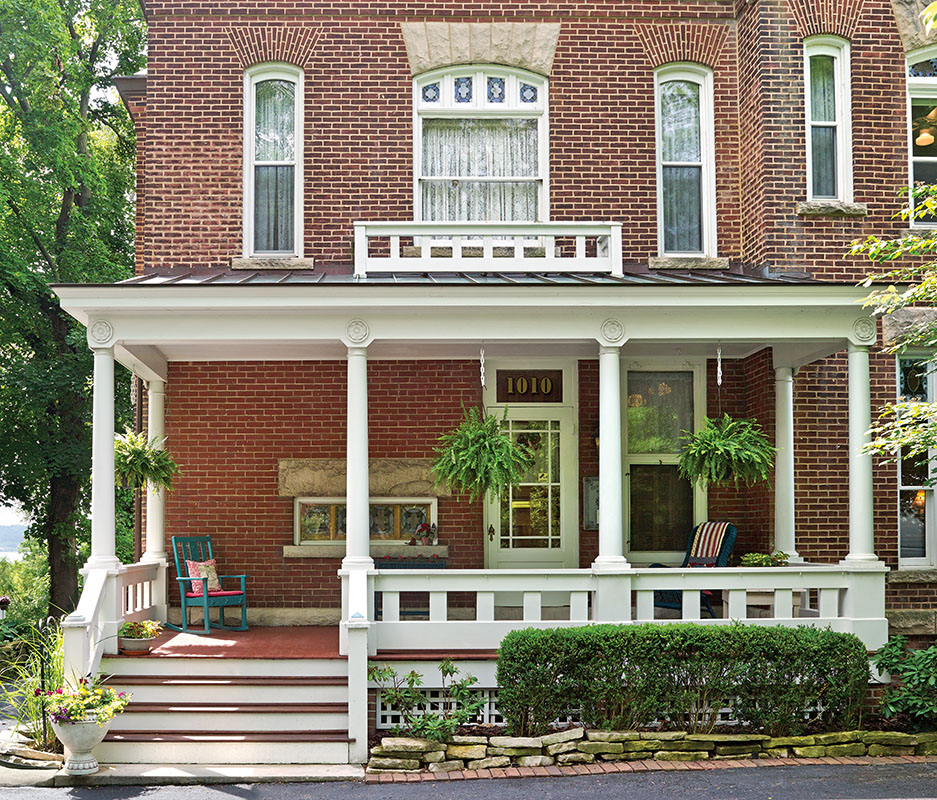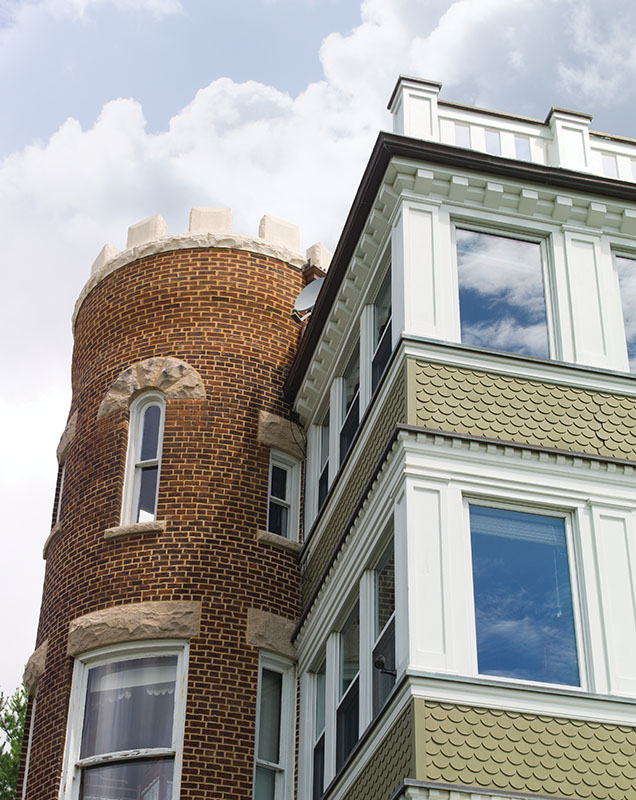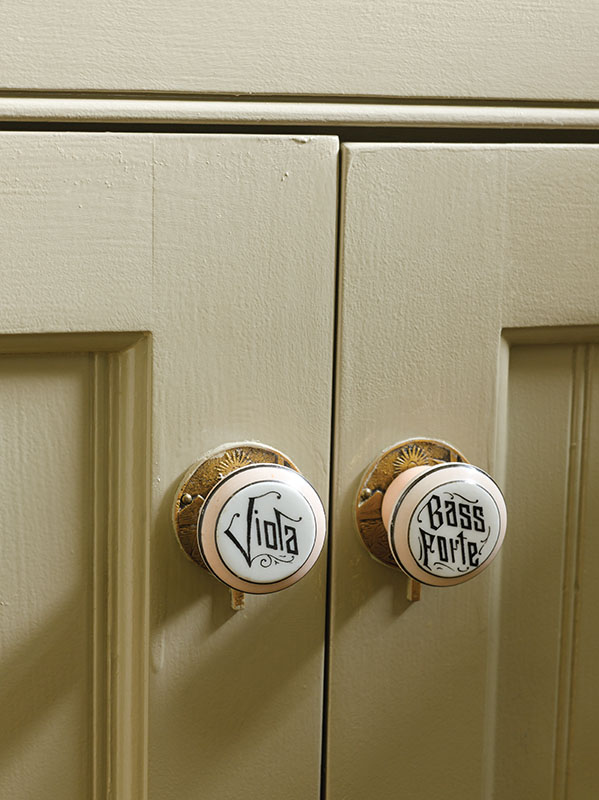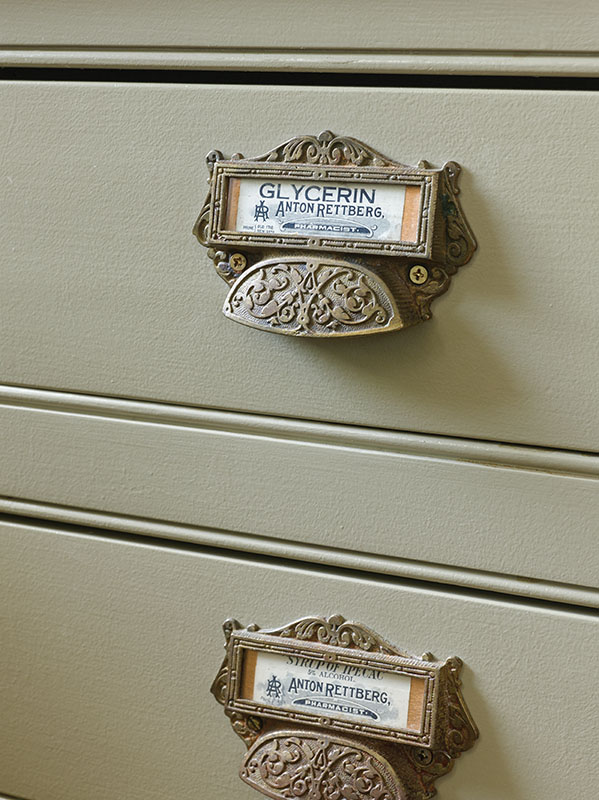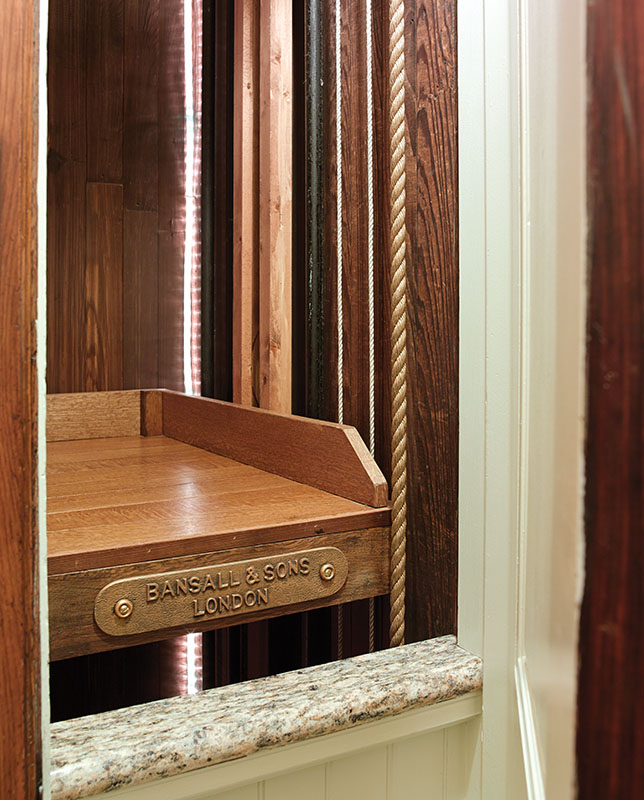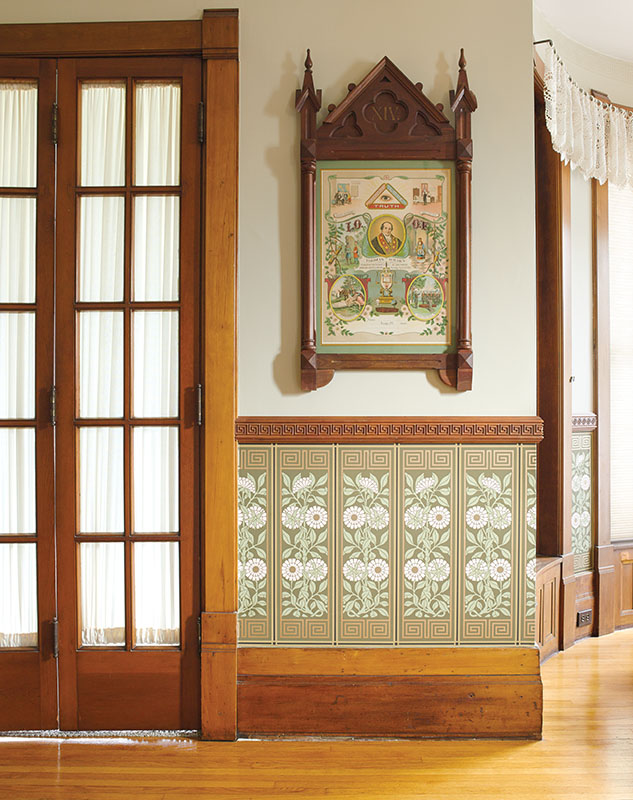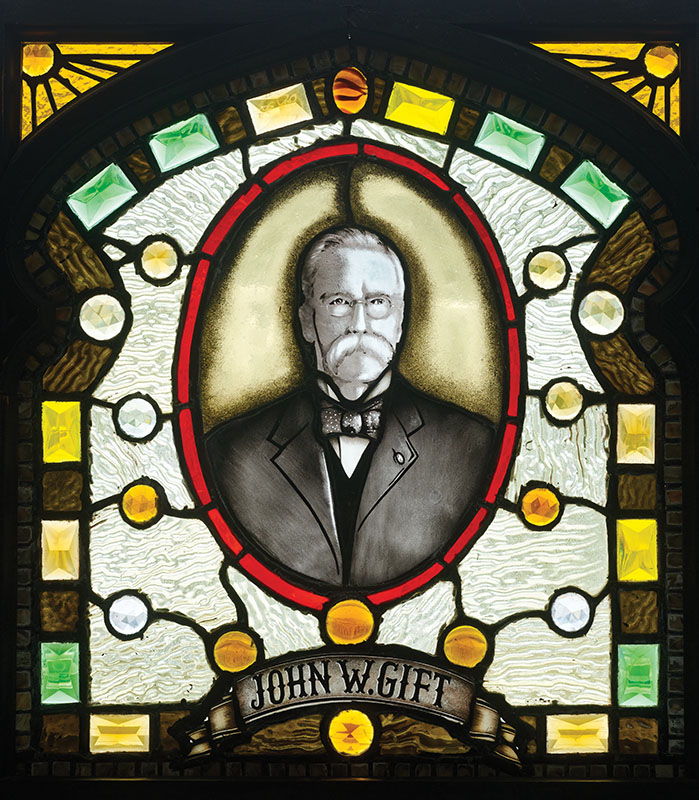Photos by Gridley+Graves
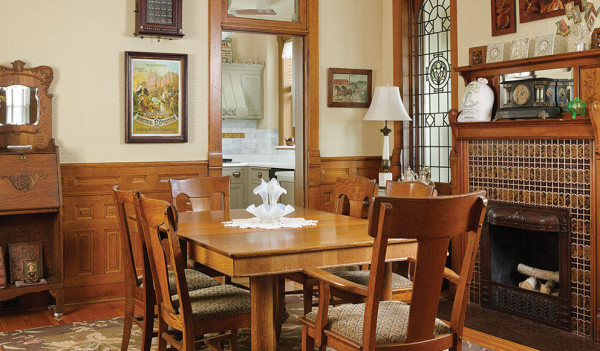
The low oak wainscot and preponderance of windows lends a sweetness unusual for Victorian dining rooms. The leaded glass pair is from salvaged 19th-century French doors.
The red-brick exterior of this Romanesque Revival tower house gives little hint of the cheerful rooms inside. Light dances through tall windows fitted with stained glass, through door transoms and over burnished oak. A sunroom offers a spectacular view over the Illinois River and downtown Peoria. This house had never lost its integrity, although “in the ‘before’ pictures, it looks abandoned,” say the owners.
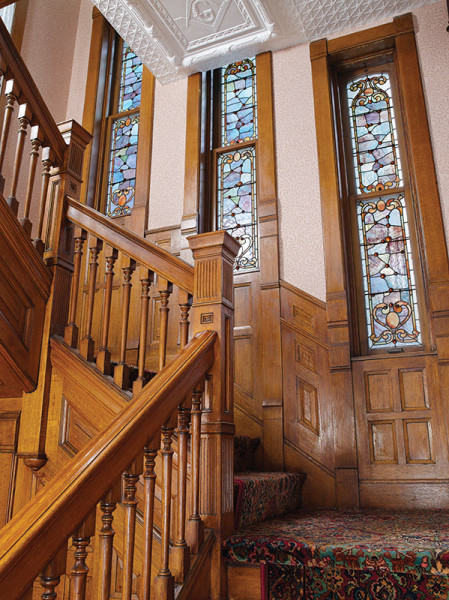
Light streams through tall stained-glass windows, reflecting off the patina of oak woodwork complemented now by a Morris-inspired wallpaper.
Dr. Z. and Nancy Vesoulis consider themselves caretakers of the J.W. Gift house, built in 1890 in the Glen Oak Historic District. Its builder owned a pioneering flour mill in Peoria. Even beyond portraits of Gift that hang in the house, his personality is felt. The crenellated tower suggests a domestic castle, the interior looks toward a new century. While many fine Victorian houses are heavy with carved walnut, this one has woodwork designed with a lighter hand. The house was modern for its time, built with electricity, forced-air central heat, and tiled bathrooms.
The Vesoulises relocated here when Z., who was trained at the Cleveland Clinic and is now retired, accepted a job at a medical center in Peoria. They were, indeed, looking for a historic house, outside the city. “Most of them had been redone in the 1970s,” Z. recalls. “Their architectural details were missing.” Then their agent took them to this house just blocks from the medical center. “I took in the view of the river, then I saw all this woodwork—I was sold.”
The couple’s first home was a seven-gabled 1870s Carpenter Gothic in New York State, “a disaster inside and out. I may have gone to medical school,” Z. says, “but my mother, when she saw that house, cried, ‘We expected so much more from you, son!’”
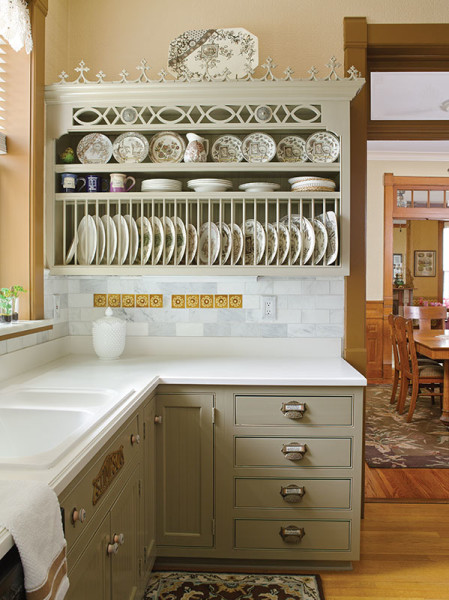
A kitchen overflowing with details.
“We got burned out,” they agree, and their next house, in Ohio, was a brand new Cape; they fitted it out with architectural salvage, and lived there for 17 years. But “Nancy and I are old-house buffs,” Z. explains, “and we really enjoy taking Victorians back to original condition. We hang out at salvage yards all over the eastern United States. A recent favorite is the Wooden Nickel in Cincinnati.”
There was work to do. In the 1920s, the top of the corner tower was lopped off and reroofed. “It was eight or 10 feet too short,” Z. says; at the parapet, the limestone blocks that formed crenellations, visible in an old photo, were gone. Although the couple says they’ve done 95 percent of the restoration work themselves, they hired brick- and stonemasons and carpenters for the job. It was messy and took longer than expected, but the results are spectacular. The 50-foot-tall tower looks as it should, and a new spiral stair gives access to the parapet’s view.
The couple restored the sunroom as a haven from disruption as they began their restoration on the first floor. Committed to authenticity and good craftsmanship, they took their time. Curved glass in the tower windows made them virtually irreplaceable, so Z. carefully restored them, using Abatron epoxy consolidants and putty fillers to rebuild sashes ruined by dry rot. Z. says that restoring the old dumbwaiter was a fun project. He had help from his son Zachary, a St. Louis neonatologist. “He’s also an old-house owner,” Z. says. The two found themselves in a precarious position as they installed lights in the three-storey shaft. Now the tray on ropes hauls groceries and luggage up and down.
Original woodwork is quarter-sawn red oak in main rooms downstairs and red birch on the second floor. Original mantels are mahogany.
The Vesoulises have created displays in homage to the house’s history. One holds souvenirs from the 1893 Columbian Exposition in Chicago and the 1904 St. Louis World’s Fair, both attended by the Gift family.
The connections go on. “We hosted a Gift family reunion here in 2013,” Z. Vesoulis reveals. “We had about 40 people from Oklahoma, Indiana and Illinois, Idaho, Utah, Washington and California, and Georgia. They brought along their stories, letters, photos, books…It was an amazing experience that Nancy expertly planned.”
Kitchen Whimsies
The kitchen is relatively small by today’s standards, and it is unabashedly modern. But oh the details! Adding to the Victorian Revival spirit: a multi-element tin ceiling from W.F. Norman, painted cabinets with beadboard inserts, cast-iron fence-post finials at the top of upper cabinets, marble subway tiles with antique ceramic-tile accents, even ceramic knobs that came from a pump organ. New appliances were built in. (The room is all new—the original kitchen had been in the basement.)
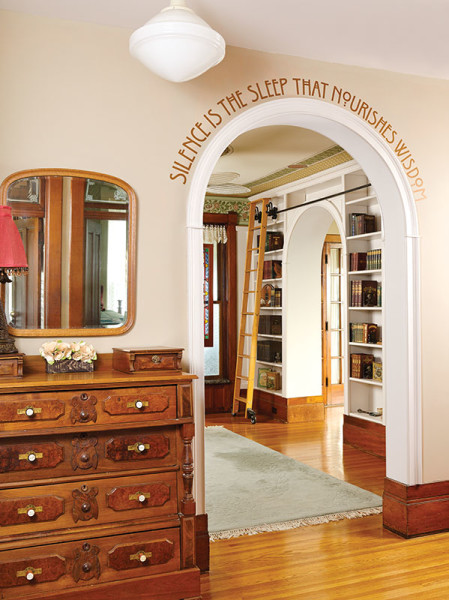
Quotations like this one lettered above the library entry add another Arts & Crafts note.
Restoring the House that John W. Gift Built
Like many old-house owners, the Vesoulises were drawn into local history through their home. They have learned a lot about its builder, an honored citizen of Peoria. John Wilson Gift (1840–1927) built the house on a bluff with a view that stretched to his factory, the Globe Roller Mills; he was a pioneer in the flour-milling trade. He was also a Civil War captain captured at Shiloh and held as a prisoner of the Confederacy, an inspiring speaker, and a philanthropist (funding, for one, the Gift Home for Children in Peoria). As an opera lover, he often traveled to Chicago for musical productions. The famed singer Emma Abbott, known as the Pride of Peoria, performed many times in this house. Gift’s flour sacks were printed with her image and that appellation. Gift’s biography was written by his second wife, Mae Harvey Gift, whom he married when he was 77 and she 32; she converted him to the Bahá’í faith. In the book she describes her husband’s meeting with Abraham Lincoln after Gift escaped his war imprisonment and made his way to Washington, D.C. He recalled that Lincoln gave him $5 to buy new clothes, and that the President had a raucous laugh.



